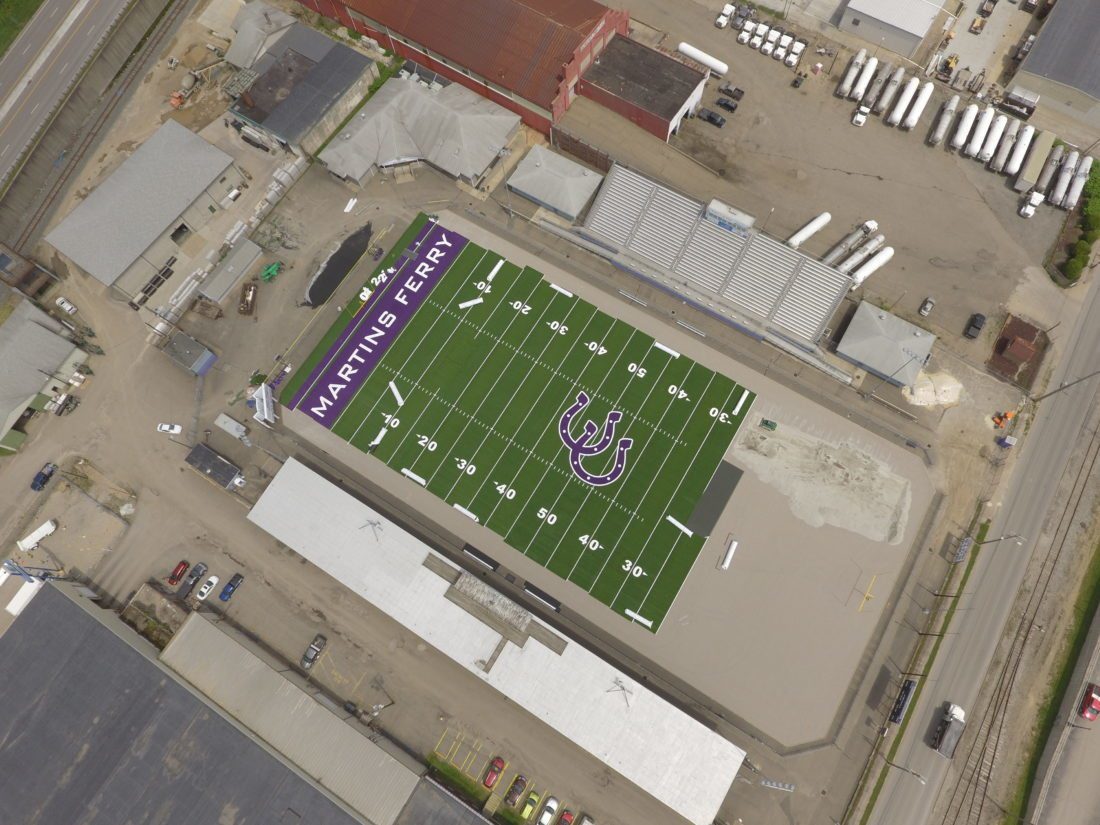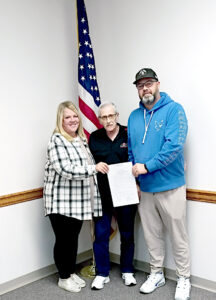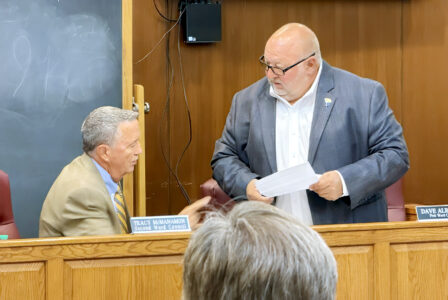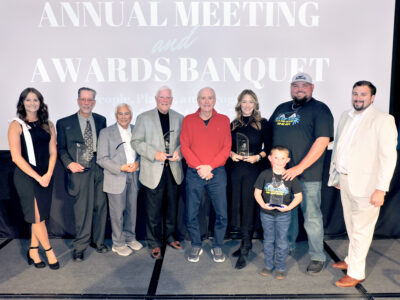Expensive artificial turf grows budgets in local stadiums

ROLLING OUT THE CARPET — Martins Ferry High School football field’s new turf is seen from an aerial view.
MARTINS FERRY — There’s a new trend spreading across the Ohio Valley — the installation of artificial turf fields at public school football complexes.
Local school systems are switching from the often laborious grass football fields that need watering, grass trimming and weekly line painting to the expensive-to-buy, yet easier-to-maintain, artificial fields. In addition to a lower-maintenance factor, it is easy to tell why school districts would want to install a turf field — they are stunning to look at. The “grass” is perfect, the lines are perfect and the school colors are beautiful and bold.
But with a price tag of $700,000 or more, do those attributes justify the cost?
The Switzerland of Ohio Local School District recently switched from grass to an artificial surface at River High School. It cost about $700,000 to install. Officials there believe that, with good maintenance, the field can last 15 years before it will need replaced.
The district used its recent oil and gas lease windfall to cover the cost of the field and a new press box. It also is planning improvements to athletic complexes and baseball and softball fields at two other schools in the district — Beallsville and Monroe Central — also funded with oil and gas money.
Regarding the improvements, the Switzerland school board’s vote to spend the money was not a unanimous one. Board member Beverly Anderson was the lone “no” vote on the spending.
Anderson said while she now supports the board’s decision, at the time she did not believe the district should spend such a large chunk of money. She wanted to first know how much money was coming to the district in the form of state and local tax allotments.
“We voted for more than just the turf field at River. We voted for athletic improvements totalling $2.6 million at River, Beallsville and Monroe Central,” she said. “I just thought we should wait until we get our next allotment to see where we were at that time.”
Anderson noted it is not just on athletics that the district is spending money, however. “We’re also spending a lot of time and effort and money on academics as well,” she said, referring to the district’s work to realign its curriculum. “I support my board members. I support the majority vote, and I support their decision.”
River High Principal Ed Trifonoff said the turf field is being used not just by the football team, but by elementary, middle and high school students during the school day.
“I really think the kids are super excited about having a new playing surface. It affords multiple opportunities for athletics and gym classes during school — we’re not limiting it to football,” he said. “It’s a true family environment. We try to do right by the kids.”
For example, in the past if it rained on a Wednesday the students would not be allowed to use the natural grass field for gym class the next day for fear of damaging it before a Friday night football game. Now, though, there is no concern about the new artificial surface becoming clumped with mud.
“There is no limit in terms of extracurriculars. Wrestling and track can use it for conditioning, and so can the baseball and softball teams. It’s a true multi-playing surface,” Trifonoff said.
The Bellaire Local Schools District does not have an artificial turf field because its stadium is in a flood zone, but it is in the process of installing a turf practice field near its new fieldhouse. Bellaire Superintendent Darren Jenkins said the field will be 80 yards long instead of the regulation 100 yards, because there is not enough space for a complete field.
Because it is smaller than usual, it will cost $250,000 to install. The district used money from its permanent improvement fund to pay for the practice field, which is being installed by Moatz Group of Cleveland. After conducting a cost analysis of re-installing a grass practice field versus a turf one, it was discovered the price, including maintenance, would be about the same, Jenkins said.
“That area gets a lot of use not only by the high school teams for practice, but the junior high as well,” Jenkins said.
The Martins Ferry City School District recently re-installed a new turf football field at its stadium on First Street. This is the second turf field placed there with the first having been installed in 2007. That surface was expected to last about eight years and instead lasted 10 years, giving the district a little more for its money. Officials hope by again taking good care of this new turf, which has a warranty of 12 years, it will actually last 15 years the second time around.
Martins Ferry City Schools Superintendent Jim Fogle said the second field actually cost one-third less than the first field. The first time around infrastructure had to be installed, such as drains and different types of gravel, before the turf was put on top.
“The cost of maintenance is minute compared to a grass surface. We have to groom the turf. It’s a tool like a rake that is pulled behind a tractor,” Fogle said.
Fogle said Martins Ferry does not have a soccer team to use the field, but its baseball and softball teams use it for early season practices.



